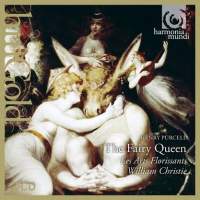Texte paru dans: / Appeared in:
|
|
|
Reviewer: Iain Fenlon
The Fairy Queen, Purcell's third semi-opera, was given for the first time at the Queen's Theatre, Dorset Gardens, in the spring of 1692. Its starting point is the text of an existing play, Shakespeare's comedy A Midsummer Night's Dream, though the original is so heavily adapted that the Bard would hardly have recognized it. This practice of modifying an existing stage work, not only by changing the words but also by adding new episodes which often involved music and elaborate scenic effects, was a standard practice in the seventeenth-century English theatre. At this year's Aix-en-Provence Festival (1990), William Christie and Les Arts Florissants together with the Peter Hall Theatre Company directed by Adrian Noble and the Compagnie Ris et Danserlies, staged The Fairy Queen complete, though ironically , while Christie paid maximum attention to questions of authenticity, Adrian Noble preferred to restore much (though not all) of Shakespeare's original… The result was clearly something of an oddity, a version which never in fact existed, but one exciting consequence of the enterprise has been a new recording of the complete Purcell score, the first to be made since John Eliot Gardiner's pioneering efforts of eight years ago (Archiv Produktion) .
In comparing these two, Christie's version is the clear winner on nearly all counts. At a fundamental level, it is simply that his approach to the music is inherently more imaginative and dramatic than Gardiner's. Take, for example, the question of orchestration. The Gardiner recording makes use of a basic continuo grouping (cello, violone, bassoon, lute and harpsichord) which supports two violins, two recorders and two oboes, an arrangement perfectly in keeping with contemporary practice but one that provides a comparatively restricted palette. Christie, on the other hand, deploys a much larger ensemble with a greater variety of continuo instruments, a bigger string section, bassoons and trumpets in addition to recorders and oboes, and percussion (used to great effect in the opening scene of Act 2 as well as in the dialogue between Corydon and Mopsa in Act 3). Until we know more about the make-up and size of the orchestras in the London theatres at the time, neither approach can be said to be the more valid, and the surviving musical sources give plenty of room for manoeuvre. But with larger forces at his disposal Christie is able to adopt a more colouristic attitude, whether by using special (and, it has to be said, unspecified) effects such bassoon glissandos in the Drunken Poet's scene, or just by creating more varied sounds in the instrument movements .
Variety is
also the key to Christie's approach to the vocal music; in dispensing with male
falsettists to sing the alto lines he is following recent research which shows
that high tenors were probably used in Purcell's time, and by performing the
work at the lower pitch of A = 392 he makes it possible to do so. The chorus
itself is the sum total of the soloists, again a practice almost certainly
followed in the seventeenth century. And, as with the orchestra, so too with the
voices in the sense that Christie draws upon a large ensemble of singers
including not only regular members of Les Arts Florissants but also others such
as Nancy Argenta (who gives a strongly dramatic reading of Night in Act 2), and
Lynne Dawson. Among the many high points must be singled out Bernard Deletré's
finely delineated account of the Drunken Poet in the First Act, and the
deliciously comic exchange between Deletré and Jean-Paul Fouchecourt as Corydon
and Mopsa. There are some fine things on the Gardiner record, but at every
juncture the Christie version seems more sharply characterized and succeeds in
conveying the complete emotional range of Purcell's music, from wit to mystery
with much in between, with great musicality, style and elegance. The result is a
must for anyone with a serious interest in the music of England's finest baroque
composer. |
|
|
|
|
|
Cliquez l'un ou l'autre
bouton pour découvrir bien d'autres critiques de CD |
|




